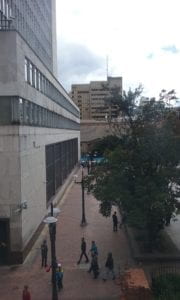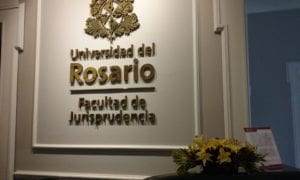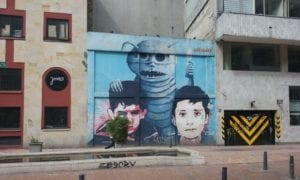Liza Martinez
Universidad del Rosario, Environment and Human Rights Research Group
Bogotá, Colombia
Hello from Bogotá, the capital of Colombia. With over 10 million people, Bogotá seems to be the place where all the craziness of this country converges. The combination of high costs of living despite high levels of poverty, the heavy traffic full of expensive cars for “high-class” people and an overcrowded public transportation system for low-income people, and the low levels of perceived sense of security in the city, gives a sense of absurdity that is very enjoyable. A study published in the larger newspaper in the country the day after my arrival showed that only 20% of the people living in Bogotá feel safe. However, life here is very similar to life in New York.

Upon my arrival to Bogotá, the city entered “protest” mode. The teachers and other public sectors went on strike for more than three weeks, asking the national government for better working conditions. I have had the opportunity to evidence the business of the city during the protests, since the office of the Environment and Human Rights Research Group of the Universidad del Rosario is located in the downtown area, just two blocks away from the Plaza de Bolivar, where the headquarters of the national government are located.
From the window of my office, I would see the protest marchers on their way to the plaza. They would chant loudly as they agglomerated in the plaza to protest as one. Since the marchers were numerous, they caused a lot of mobility disturbance. There were several days when I had to work from home.

 Working with the Environment and Human Rights Research Group has been an interesting experience. During my first week in Bogotá, I met with the director of the Office of Environmental Issues from the Ministry of Mines and Energy. At the end of the week, I joined a meeting with a “collaborative group” composed of government stakeholders who work on issues related to artisanal small-scale gold mining (ASGM) in the country.
Working with the Environment and Human Rights Research Group has been an interesting experience. During my first week in Bogotá, I met with the director of the Office of Environmental Issues from the Ministry of Mines and Energy. At the end of the week, I joined a meeting with a “collaborative group” composed of government stakeholders who work on issues related to artisanal small-scale gold mining (ASGM) in the country.

In the meeting, there were officials of the army in charge of the Brigade Against Illegal Mining (created in 2015), representatives from the Office of the Ombudsman, the office of the Attorney General and all the members of the research group I am part of. I presented my project during the meeting, and the people from the ombudsman’s office expressed interest in collaborating with me. They conducted a similar study in 2015 and mentioned that they had difficulties with the data collection because the communities they investigated had little trust in governmental offices. “Coming from academia,” they told me, “the communities will be more open to talk with you.”

One thing that has been a challenge for me is to understand the point of view of the representatives of the Colombian government. As a Colombian, I am familiar with the generalized mistrust in government offices here; it seems to be the norm for Colombians. However, entering the government offices and talking with people who are working hard to improve the current catastrophic situation caused by the use of mercury in ASGM has challenged my personal assumptions.
These individuals seem eager to work hard to overcome the difficulties they themselves are encountering in improving the country’s environmental and social issues due to ASGM. They also acknowledge that there is corruption and talk openly of the disasters that it causes in building the government’s credibility.
In sum, my time in Bogotá and with the research group has been very rich, and I have felt welcomed by the team as well as by the entire city. In my next blog, I will detail the issues of gold and mercury and the economics around them. Keep reading!
